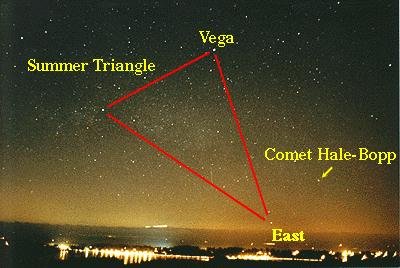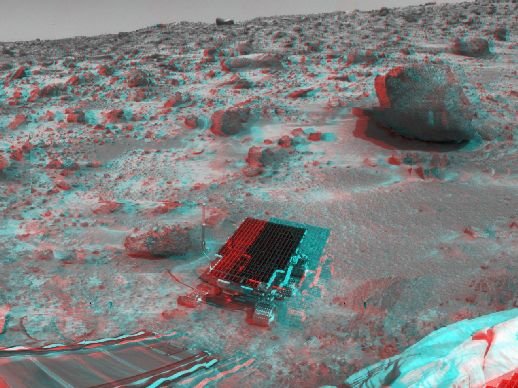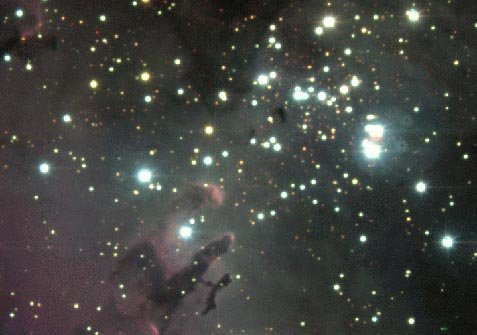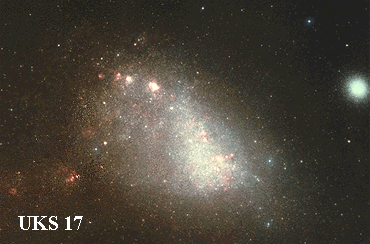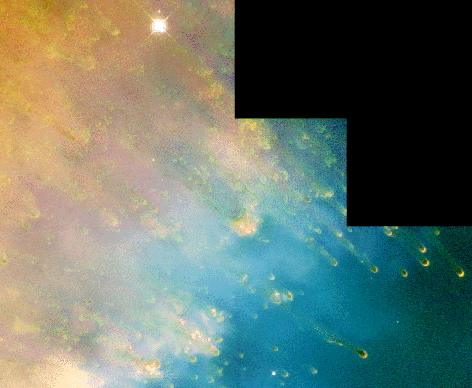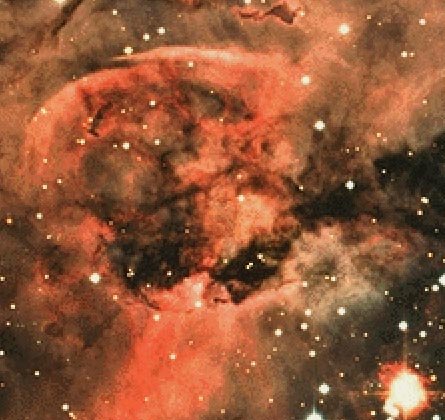NASA APOD #757-763
#757 Vega July 15, 1997
“Vega is a bright blue star 25 light years away. Vega is the brightest star in the Summer Triangle, a group of stars easily visible summer evenings in the northern hemisphere. The name Vega derives from Arabic origins, and means "stone eagle." 4,000 years ago, however, Vega was known by some as "Ma'at" - one example of ancient human astronomical knowledge and language. 14,000 years ago, Vega, not Polaris, was the north star. Vega is the fifth brightest star in the night sky, and has a diameter almost three times that of our Sun. Life bearing planets, rich in liquid water, could possibly exist around Vega. The above picture, taken in January, finds Vega, the Summer Triangle, and Comet Hale-Bopp high above Victoria, British Columbia, Canada."
Copyright: Public domain
#758 Mars: Yogi And Friends In 3D July 16, 1997
“A ramp from the Pathfinder lander, the Sojourner robot rover, airbags, a couch, Barnacle Bill, and Yogi Rock appear together in this 3D stereo view of the surface of Mars. Barnacle Bill is the rock just left of the solar-paneled Sojourner and Yogi is the big friendly-looking boulder at the right. The "couch" is the angular rock shape visible on the horizon. Look at the image with red/blue glasses (... or just hold a piece of clear red plastic over your left eye and blue or green over your right) to get the dramatic 3D perspective. The stereo view was recorded by the remarkable Imager for Mars Pathfinder (IMP) camera. The IMP has two optical paths for stereo imaging and ranging and is equipped with an array of color filters for spectral analysis. Operating as the "first astronomical observatory on Mars" the IMP has also recorded images of the Sun and Deimos, the smallest of Mars' two tiny moons. Overcoming communications problems and computer resets the Pathfinder is transmitting new color images which should be available July 18."
Copyright: Public domain
#759 Message from Earth July 17, 1997
“What are these Earthlings trying to tell us? The above message was broadcast from Earth towards the globular star cluster M13 in 1974. During the dedication of the Arecibo Observatory - still the largest radio telescope in the world - a string of 1's and 0's representing the above diagram was sent. This attempt at extraterrestrial communication was mostly ceremonial - humanity regularly broadcasts radio and television signals out into space accidentally. Even were this message received, M13 is so far away we would have to wait almost 50,000 years to hear an answer. The above message gives a few simple facts about humanity and its knowledge: from left to right are numbers from one to ten, atoms including hydrogen and carbon, some interesting molecules, DNA, a human with description, basics of our Solar System, and basics of the sending telescope. Several searches for extraterrestrial intelligence are currently underway, including Project Phoenix under the direction of Dr. Jill Tarter."
Copyright: Public domain
#760 Blue Stars and Red Pillars July 18, 1997
“Bright blue stars are still forming in the red pillars of the Eagle Nebula. Made famous by a picture from the Hubble Space Telescope in 1995, the Eagle Nebula shows the dramatic process of star formation. To the upper right of the nebula in the above picture lies the heart of the open cluster M16. This picture closely depicts the true colors of the stars and nebula. The bright blue stars of M16 are continually forming from the Eagle Nebula gas, most recently in the famous gas and dust pillars seen below the photo's center. Of all the young stars in M16, the most massive shine the brightest and the bluest. A typical age for a star in this cluster is about 5 million years, making them only 1/1000 the age of our Sun. Light takes about 7000 years to reach us from M16."
Copyright: Public domain
#761 The Small Cloud of Magellan July 19, 1997
“The southern sky contains wonders almost unknown in the north. These wonders include the Large and Small Magellanic Clouds: small irregular galaxies orbiting our own larger Milky Way spiral galaxy. The Small Magellanic Cloud (SMC), pictured here, is about 250,000 light years away. The SMC contains many young, hot, blue stars indicating it has undergone a recent period of star formation, possibly due to a collision with the LMC 500 million years ago. The bright object on the right is a globular cluster near the outskirts of the Milky Way."
Copyright:
Anglo-Australian Telescope Board
#762 At the Edge of the Helix July 20, 1997
“While exploring the inner edge of the Helix Nebula with the Hubble Space Telescope's Wide Field Planetary Camera 2, astronomers were able to produce this striking image - rich in details of an exotic environment. This planetary nebula, created near the final phase of a sun-like star's life, is composed of tenuous shells of gas ejected by the hot central star. The atoms of gas, stripped of electrons by ultraviolet radiation from the central star, radiate light at characteristic energies allowing specific chemical elements to be identified. In this image, emission from nitrogen is represented as red, hydrogen emission as green, and oxygen as blue. The inner edge of the nebula (the direction to the central star) is toward the bottom right. Clearly visible close to the inner edge are finger shaped "cometary knots"."
Copyright: Public domain
#763 In the Center of the Keyhole Nebula July 21, 1997
“Stars, like people, do not always go gentle into that good night. The above Keyhole Nebula results from dying star Eta Carinae's violently casting off dust and gas during its final centuries. Eta Carinae is many times more massive than our own Sun, and should eventually undergo a tremendous supernova explosion. Eta Carinae emits much light in colors outside the human visible range. This past week, X-ray emission from Eta Carinae was verified by the orbiting Rossi X-Ray Timing Explorer to be periodic, peaking every 85.1 days. This, along with a previously hypothesized 5.52 year period, indicates that the dying star might be part of a multiple star system."
Copyright: AAOAATBUKS Telescope
Upvote! Resteem! Comment! As you like it! Thank you for attention!
